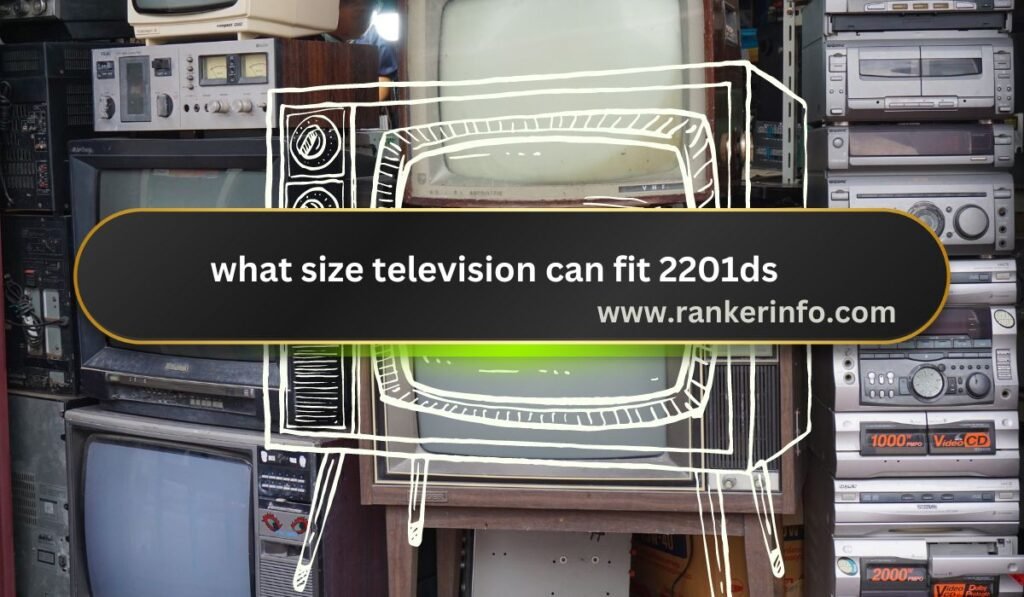What size television can fit 2201ds Choosing the appropriate size of television means getting to understand the dimensions of your 2201ds space and the optimal viewing distance. This guide will walk you through the key factors in choosing a TV size that fits your needs. Later in this paper, we will provide useful data-driven insights, useful tips, and answers to some of the frequently asked questions that will enable you to make your decision. In this article, by the end of it, you will know the precise size of the television that would fit your 2201ds space to give you the ultimate view.
What size Television can actually fit a 2201ds?
In determining the correct size of a television that fits your space, 2201ds, one has to take into consideration the size of the room, furniture in it, and how far viewers must be from the television for comfortable viewing. Commonly, a television is measured diagonally from one corner to another, which gives its size. This will determine whether a television will fit in your space and not overwhelm the room with its presence.
Optimal Viewing Distance for TVs of Various Sizes
The viewing distance away from your television set highly depends on the size and resolution of the TV itself. A bigger TV for instance would require sitting further to get the best out of it. For smaller ones, however, one can sit closer but it results in no dire effect to their vision. Below is a table that gives an approximate ideal viewing distances in relation to the size of a television.
Also read more: beanbag plant
Table 1: Ideal Viewing Distance for Different TV Sizes
| TV Size (inches) | Viewing Distance (feet) | Resolution |
|---|---|---|
| 32 | 4.5 – 6.5 | 1080p |
| 40 | 5.5 – 8.5 | 1080p |
| 50 | 6.5 – 10.5 | 1080p |
| 55 | 7.5 – 12.5 | 4K Ultra HD |
| 65 | 8.5 – 13.5 | 4K Ultra HD |
| 75 | 9.5 – 15.5 | 4K Ultra HD |
| 85 | 10.5 – 17.5 | 4K Ultra HD |
These figures are guidelines and can vary based on personal preferences and the specific configuration of your 2201ds space.
Calculate what size television can fit 2201ds
Measure Your Space
Before you try to find the idea of size of the TV concerning the space, first things first; you have to measure the area of your space where you are going to mount your television set. Now take a close look at the following ways of measurement:
- Wall Space: An approximation of width and height of the wall on which the TV would go on, mounted or placed on a stand.
- Furniture Layout: Understand how to place furniture like sofas and chairs, keeping in mind positions for an ergonomic view of the TV.
- Distance from seating area: This is going to be the calculation of distance between where one sits to view and where the television will be placed, using it to assume preferred viewing screen size.
Room Size and TV Placement
- Room size: It will be highly determined by the size of the room where it is going to be installed. A big-sized room may support a big screen television while a small-sized room may be better supported by a compact screen. Placement on the wall, stand-mounted, or embedded in a cabinet also influences the size you’ll require.
Wall-Mounted vs. Stand-Mounted TVs
A couple of options when it comes to considering space availability and how the room is set up include wall-mounted and stand-mounted. Wall-mounted TVs save precious floor space and can add a sleek look to a modern room. However, they usually require perfect measurements during installation in order to enjoy a perfect angle of view. Stand-mounted TVs offer greater flexibility as regards placement but may need extra furniture for support.
Dimensions and Aspect Ratios of TVs Understanding Dimension While a TV is measured on its diagonal, when it comes to trying to fit it into your available space, knowing the actual width and height is very important. Below are some common TV sizes, with their approximate dimensions in width and height.
Table 2: TV Dimensions Based on Screen Size
| TV Size (inches) | Width (inches) | Height (inches) |
|---|---|---|
| 32 | 28 | 16 |
| 40 | 35 | 20 |
| 50 | 44 | 25 |
| 55 | 48 | 27 |
| 65 | 57 | 32 |
| 75 | 66 | 37 |
| 85 | 74 | 42 |
These dimensions are approximate and can vary slightly depending on the TV model and brand.
Most of the latest TVs boast a 16:9 aspect ratio, and as such they are ideal for widescreen viewing. If in any case you might want to view older contents or may need it for other format, an aspect ratio is something you should consider when choosing your size.
Also read more: fixchinacarrier
TV Resolution and How It Relates to Your Choice of Size
Understanding TV Resolution
Resolution refers to the number of pixels constituting the image on your screen. The sharper and finer an image, the higher its resolution will be. Here are a few standard resolutions:
- 1080p Full HD: 1920 x 1080 pixels – this is an okay size for small screens or low-priced models.
- 4K Ultra HD: 3840 x 2160 pixels – four times the resolution of 1080p; best for big screen TVs.
- 8K Ultra HD: 7680 x 4320 pixels-future resolution, best for very large screens or future proofing.
Resolution’s Impact on Viewing Distance
The idea here is that at higher resolutions, you can sit closer to the screen without seeing any pixelation. That puts it into perspective when you consider how, with a 4K TV, you can draw closer to the screen than some 1080p of the same size and keep it clear. You can go larger on-screen size, even in small-sized rooms, provided the resolution of the TV is high enough.
Room configurations according to popular sizes of TVs include: Small rooms and bedrooms require 32-inch to 40-inch TVs that give good balance due to screen size in space so that the TV will not overpower the room.
Fairly Medium-Sized Living Rooms
Normally, the size for a medium-sized living room will go up to 50″ to 65″. Such screen sizes will provide an immersive view without taking up much space. A resolution of 4K with those screen sizes is recommended so that images can be maintained at clear and crisp conditions.
Large Living Rooms or Home Theaters
With the screen sizes ranging from 75-inch to 85-inch, for sure, one can easily present a much more cinematic view for larger areas of the living room if not at home theaters. A screen this big is best viewed from at least 9.5 feet away and hence fitted in spacious rooms.
Table 3: Recommended TV Sizes Based on Room Size
| Room Size (sq. ft) | Recommended TV Size (inches) | Optimal Viewing Distance (feet) |
|---|---|---|
| 100-200 | 32-40 | 4.5 – 8.5 |
| 200-400 | 50-65 | 6.5 – 12.5 |
| 400+ | 75-85 | 9.5 – 17.5 |
How to Choose Correct TV Size for 2201ds Space
Consider your viewing habit
Your viewing habits are going to play a significant difference in the size of the TV that you choose. If you like to watch movies, play video games, or even watch sports, then you enjoy a big screen. On the other hand, if you spend most of your time watching the news or sitcoms, then you can easily get away with a smaller TV.
Account for Room Lighting
That would affect what the picture would look like under some of the lighting conditions in your room. If your 2201ds room is very bright, you would require an even brighter TV for glare compensation. A little light in a room enables a wide window for options of size without depreciation of picture quality.
Future-Proofing Your Purchase
Future-proofing the TV will mean investing in a newer, fresher device with 4K or 8K resolution, HDR, and/or Smart TV capabilities to keep it relevant for several years.
Frequently Asked Questions about TV Size for Room 2201ds
1. What size of TV is best suited for a 2201ds room?
That would be an ideal size for a TV in the 2201ds room, considering the size of the room and how far one is from the view. Generally, you’re okay on 50-65-inch TVs in a medium-sized room, but on larger rooms, those could go to 75-85 inches.
2. How can I measure my space to get the right size of a TV?
Some easy math, approaching the issue of measuring the width and height of the wall on which your TV is going to be and also how far from the seating area it will be. Take those measurements and figure out the appropriate size for your TV based on viewing distance, explained below.
3. Can a big screen be mounted on the wall in 2201ds space?
Yes, you can install a big screen on the wall in the given space of 2201ds if it could bear the weight. Place the television at eye level and there should be enough viewing distance to utilize the screen fully.
4. Does resolution make any difference in size I must select?
The resolution would make a big difference in the size that one chooses for a TV; considering the higher resolution TVs such as the 4K and 8K TVs, one is able to sit even closer to the screen without any distortion of the image occurring; hence, one can choose an even larger TV despite smaller rooms.
5. What would be the ideal viewing distance for a 65-inch TV in 2201ds space?
The view distance at this size would therefore be best in a 2201ds space distance at approximately 7.5 to12.5 feet, to clearly give a clear view perspective without causing eye strains.
6. How does the aspect ratio influence one to select a particular size of the TV?
Aspect Ratio describes the overall shape and size of the screen. The most common for modern TVs is 16:9, which works very well with widescreen viewing. However, this might affect the size choice that one would make for the TV if he or she intends to view content made in an older format, that is, with a different aspect ratio.
Conclusion
We must consider a few important parameters when determining the size of any television that would be able to fit in the 2201ds: room dimensions, viewing distance, and the resolution of the television itself. Through the guiding principle and recommendations included in the foregoing article, one can precisely estimate the ideal-sized television that would suit a room perfectly and provide the best view, be it the setup of a small bedroom or the arrangement of a big home theater. Besides viewing habits, the relation of TV size to room size is important to be known.

